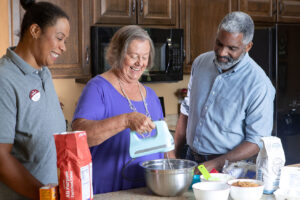Sponsored content by Nikki Easton, Brand Ave. Studios contributing writer
When a loved one has been diagnosed with Alzheimer’s disease or another form of dementia, they may eventually need more care than you can provide at home. At that point, it will be necessary to find a community that can better meet their needs.
Not all memory care communities are alike. Choosing the right one will make a huge difference in your loved one’s quality of life and may even slow the progression of the disease.
It’s a good idea to tour a community before making a final decision. These tips will help you make a thorough assessment.
First impressions
The tour begins as you drive up to the community. Is it in a pleasant neighborhood? Are the grounds clean and well-tended? Is there an attendant at the reception desk to screen visitors? Are the communal areas clean, well-kept and attractively decorated? Is there background music playing, something a memory care community should use to set the right mood for each time of day? Are there green spaces and gardens that promote positive mood states, serenity and relaxation?
Residents
As you walk through the common areas, what do you notice about the residents? Do they look well cared for? Are they involved in an activity? Is the staff actively engaged with them or are residents sitting by themselves moving about without apparent purpose or engagement?
Person-centered care
According to the Alzheimer’s Association, the gold standard of care for people with dementia is based on a person-centered philosophy. This is a nonjudgmental approach that accepts each individual as they are and uses proven methods to encourage understanding of each resident’s perception of time and place, and validating that perspective.

Staff training
Has the staff been trained in dementia care that puts the person first?
Primrose has partnered with the National Council of Certified Dementia Practitioners to train its staff accordingly, including caregivers, department heads and even their sales teams. This training teaches staff about the underlying changes in the brain that cause different forms of dementia, including Alzheimer’s and Lewy body dementia. This knowledge, coupled with the tools of a person-centered approach, allows staff to provide the most effective and empathetic care.
Life enrichment
Make sure the community offers a range of activities that are both enjoyable and therapeutic. These should include physical movement and exercise; opportunities for social interaction; and creative activities, like art and music, which are not only pleasurable but a helpful form of expression.
Living quarters
Unlike a nursing home, with its hospital-style rooms, a good memory care community will have homelike apartments specially adapted to the needs of people with dementia. This should include space to add personal touches like art, photographs and mementos, which can be a great comfort to residents.

Safety and emergency preparedness
Keeping your loved one safe is, of course, a top priority. Wandering is common in people with dementia, so check that access to the building is secured both for entry and exit. Are there sufficient team members to ensure regular support of resident needs? Are there ample, well-placed fire alarms, smoke detectors and security cameras? What are the safety procedures in case of fire, flood or contagious disease?
The community/family relationship
Be sure to find out if the community is proactive about communicating and building a relationship with family members. At Primrose, providing resources, compassion and support to each resident’s family is part of their mission.
Once your loved one has moved into the right memory care community, you’ll probably see some wonderful changes in your relationship. Instead of the stress and difficulties you’ve been dealing with, you can rediscover the pleasure of spending time in each other’s company.
For more information or to find a Primrose community that offers memory care services near you, visit Silver Lace Memory Care by Primrose Retirement | Primrose.
